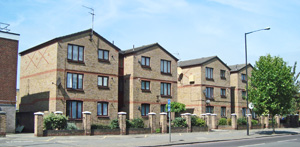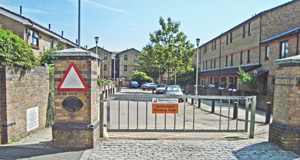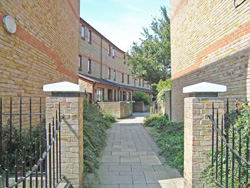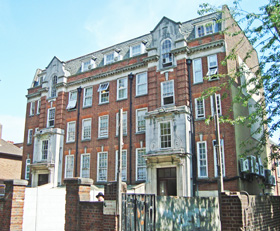British Asylum for Deaf and Dumb Females
26 Clapton Common, Hackney, E5 9BA
Medical
dates:
Medical
character:
Specialist
The British Asylum for Deaf and
Dumb Females was founded in May 1851 in Stamford Hill by Mr and Mrs
Sutton following an incident involving two deaf and dumb women, who had
walked into the road in front of their horse-drawn carriage (it had
been "necessary for the footman to go to them"). The Suttons'
interest was aroused in their plight and they called together a
committee of ladies and gentlemen to establish an institution to
provide education, training and religious instruction to female
deaf-mutes over the age of 10 years. It was the only such
institution in the United Kingdom.
Free places were offered to the girls by vote of the governors and subscribers. Their education lasted for three years during which, as well as ordinary school subjects, they were taught domestic skills, laundry work and dressmaking. The Asylum also provided a home for aged and infirm deaf-mutes.
In 1857 it moved to Eagle House in Homerton (demolished in the 1950s) and then, in 1864, to an attractive Queen Anne house at No. 179 Lower Clapton Road (this house had been nicknamed Piss Pot Hall because of the large ornamental urns its previous owner, Markham Eeles, a china merchant, had placed on top of the brick piers by the grand wrought-iron entrance gates).
In 1897 the offices of the Asylum moved from No. 27 Red Lion Square to No. 5 Bloomsbury Square (now Pushkin House). In 1908 they moved to Clapton.
By the end of the 1920s the local Council, looking for a suitable site on which to build much needed housing, decided that the Lower Clapton Road would be ideal as it was reasonably central and had excellent transport links. During a government enquiry, the Treasurer of the Asylum and ex-Mayor of Hackney, Cllr W.R. Power, made an impassioned plea of behalf of the Asylum and its 37 inmates. Despite this, the enquiry found in favour of the Council, enabling it to compulsorily purchase the premises.
In 1933 the Asylum moved to a new purpose-built 4-storey building at No. 26 Clapton Common.
It closed in 1986.
Free places were offered to the girls by vote of the governors and subscribers. Their education lasted for three years during which, as well as ordinary school subjects, they were taught domestic skills, laundry work and dressmaking. The Asylum also provided a home for aged and infirm deaf-mutes.
In 1857 it moved to Eagle House in Homerton (demolished in the 1950s) and then, in 1864, to an attractive Queen Anne house at No. 179 Lower Clapton Road (this house had been nicknamed Piss Pot Hall because of the large ornamental urns its previous owner, Markham Eeles, a china merchant, had placed on top of the brick piers by the grand wrought-iron entrance gates).
In 1897 the offices of the Asylum moved from No. 27 Red Lion Square to No. 5 Bloomsbury Square (now Pushkin House). In 1908 they moved to Clapton.
By the end of the 1920s the local Council, looking for a suitable site on which to build much needed housing, decided that the Lower Clapton Road would be ideal as it was reasonably central and had excellent transport links. During a government enquiry, the Treasurer of the Asylum and ex-Mayor of Hackney, Cllr W.R. Power, made an impassioned plea of behalf of the Asylum and its 37 inmates. Despite this, the enquiry found in favour of the Council, enabling it to compulsorily purchase the premises.
In 1933 the Asylum moved to a new purpose-built 4-storey building at No. 26 Clapton Common.
It closed in 1986.
Present status (August 2011)
No. 179 Lower Clapton Road was demolished in 1933, along with much of the locality. Powell House - a complex of 5-storey apartment blocks - was built on the cleared site. It opened in May 1934 and contained 198 apartments, with accommodation for 900 people.
The final home of the Asylum - No. 26 Clapton Common - is now a part of the large local Orthodox Jewish community. It is used as a place of learning by the Kollel Congregation Synagogue.

Powell House, in its turn, was demolished around 1980 and replaced by an estate of low-rise Council housing (above and below).

The entrance to the estate from Clarence Road.

The actual site of the Asylum and its grounds in now Apprentice Way, between Lower Clapton Road and Clarence Road (above and below).


No. 26 Clapton Common is now a Jewish school.
(Author unstated) 1892 British Asylum for Deaf and Dumb Females. Charity, 1st December, 7.
(Author unstated) 2011 Home schooling. Hackney Today, 3rd October, 25.
http://archive.museumoflondon.org.uk
http://blogs.ucl.ac.uk
http://collage.cityoflondon.gov.uk
http://edithsstreets.blogspot.co.uk (1)
http://edithsstreets.blogspot.co.uk (2)
www.british-history.ac.uk (1)
www.british-history.ac.uk (2)
www.extraordinarybookofdoors.com
www.flickr.com
www.hackney.gov.uk
www.hackneysociety.org
www.oldukphotos.com
www.ucl.ac.uk
Return to home page